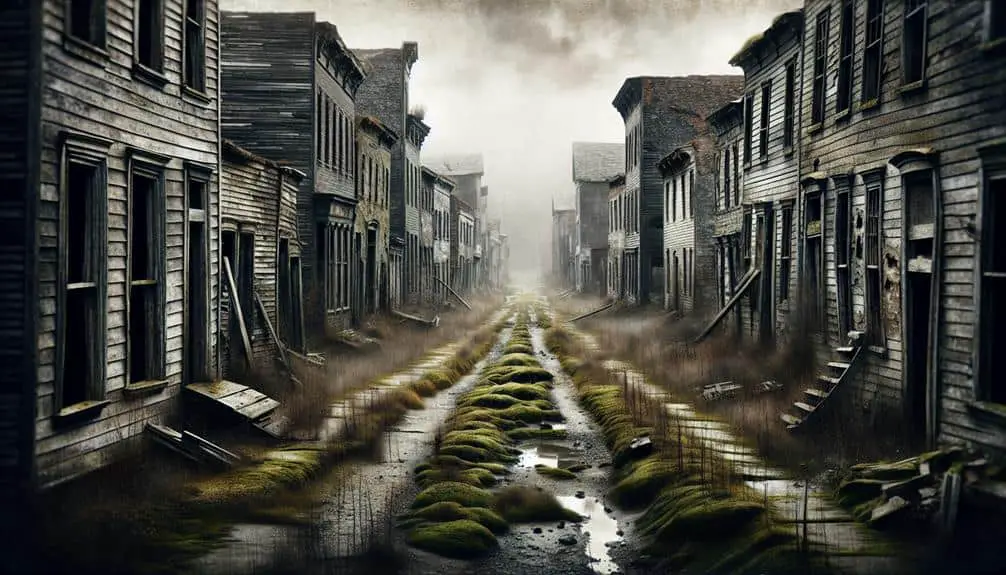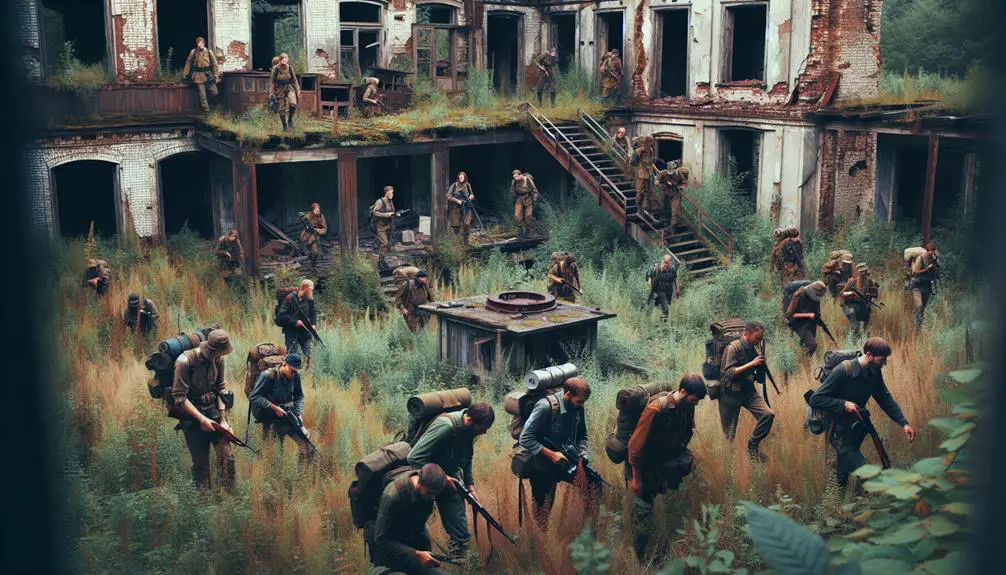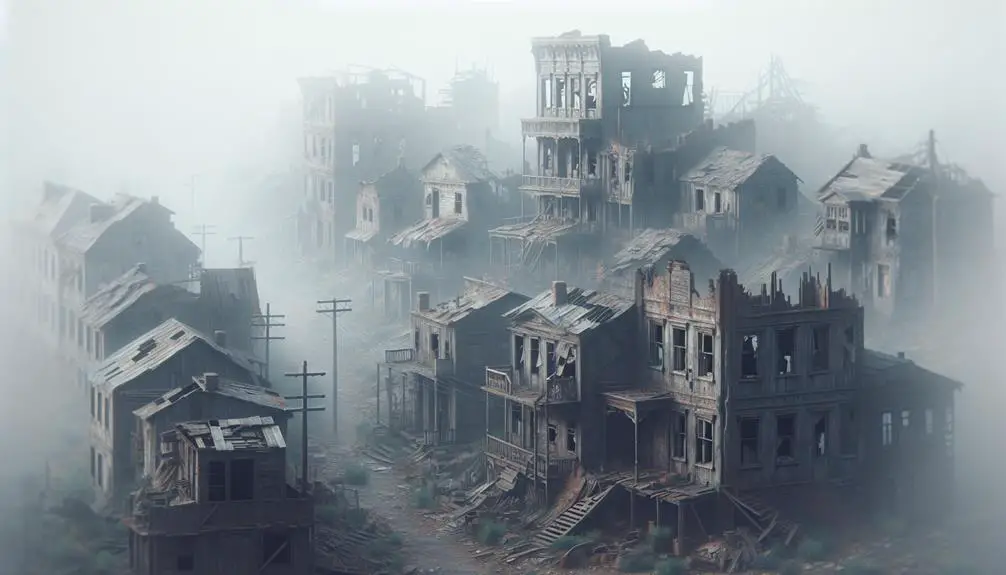During the Civil War era, ghost towns became desolate due to economic collapse. Job opportunities vanished, leading to financial instability. People flocked to urban areas for better prospects. Infrastructure decayed, impacting community well-being. The exodus to cities caused further decline in these towns. Abandoned buildings stood as symbols of urban decay. Lack of government support worsened the situation, neglecting preservation efforts. Environmental degradation and natural disasters also played a role, accelerating the decline. Understanding these factors reveals insights into past communities and societal changes. Further exploration will shed light on the intricate unraveling of historical ghost towns.
Key Points
- Economic collapse post-Civil War led to job loss and urban migration.
- Population exodus to cities for better opportunities and social ties.
- Abandoned infrastructure due to lack of preservation and government support.
- Environmental degradation and natural disasters accelerated ghost town decline.
- Lack of funding and advocacy for preservation efforts contributed to desolation.
Economic Collapse After the War
After the Civil War, the economic collapse that ensued had a profound impact on the once-thriving town, leading to widespread poverty and disarray. The economic downturn resulted in a significant decrease in job opportunities and financial stability for the town's residents. As a result, many individuals faced hardships and struggles to make ends meet, pushing them towards urban migration in search of better prospects. The lack of economic growth within the town forced people to seek livelihoods in larger cities where industries were booming post-war.
This shift towards urban migration exacerbated the town's decline, as the population dwindled, leaving behind empty homes and abandoned businesses. The economic downturn not only affected individuals and families but also had a ripple effect on the town's infrastructure and overall community well-being. The consequences of the economic collapse after the Civil War were profound, reshaping the town's landscape and pushing many towards urban centers in the pursuit of a better life.
Population Exodus to Cities
The mass migration of the town's population to urban centers following the economic collapse post-Civil War underscored the dire circumstances faced by its residents. Urban migration became a prevailing trend as people sought better economic opportunities, social connections, and access to services in cities. The allure of urban life, with its promise of jobs, entertainment, and education, drew individuals away from struggling rural areas.
This significant shift in population distribution brought about profound social changes. Families were uprooted from their long-established communities, leading to the breakdown of traditional social structures. The once tight-knit fabric of small towns began to unravel as more and more residents departed for urban areas. The exodus to cities also impacted the local economy, causing further decline in businesses and services within the ghost town.
Abandoned Infrastructure and Buildings
Amidst the desolate landscape of the Civil War-era ghost town, remnants of abandoned infrastructure and buildings stand as silent witnesses to a bygone era of prosperity and community life. The decaying structures paint a vivid picture of urban decay, showcasing the gradual deterioration of once-thriving centers of activity.
Here are three key insights into the abandoned infrastructure and buildings within these ghost towns:
- Urban Decay: The neglected buildings and infrastructure in Civil War-era ghost towns exemplify the concept of urban decay, illustrating the gradual decline of urban areas as a result of various socio-economic factors. From crumbling facades to overgrown streets, these remnants symbolize the erosion of urban environments over time.
- Historical Preservation: While many of these buildings may seem beyond repair, their historical significance can't be understated. Efforts towards historical preservation play an essential role in documenting the past and maintaining a tangible link to history for future generations. By preserving these structures, we can safeguard that the stories of these ghost towns aren't lost to time.
- Cultural Significance: The abandoned infrastructure and buildings hold immense cultural significance, offering insights into architectural styles, daily life, and societal norms of the era. Studying these remnants provides a window into the past, allowing us to piece together the narratives of these once-thriving communities.
Lack of Government Support
Regrettably, the lack of substantial government support has greatly contributed to the continued deterioration of the infrastructure and buildings in Civil War-era ghost towns. Government negligence towards these historical sites has resulted in a lack of funding for preservation efforts, leading to the decay of essential structures. Without adequate resources allocated to maintain these ghost towns, the communities that once thrived there have faced disintegration, both physically and socially.
The absence of government intervention has left these towns vulnerable to the ravages of time and neglect. As buildings crumble and roads become impassable, the historical significance of these sites is slowly eroded. The failure to protect and conserve these areas not only impacts the physical landscape but also diminishes the opportunities for future generations to learn about the history embedded in these ghost towns.
In the face of government inaction, it falls upon concerned individuals and organizations to advocate for the preservation of these invaluable remnants of the past. Without collective efforts to address the lack of government support, the continued desolation of Civil War-era ghost towns is inevitable, further perpetuating their decline into obscurity.
Environmental Degradation and Natural Disasters
Government negligence towards Civil War-era ghost towns hasn't only led to their physical and social disintegration but has also exposed these historical sites to the threats of environmental degradation and natural disasters. This neglect has created a perfect storm of conditions that exacerbate the decline of these once vibrant communities.
- Soil erosion and deforestation: The lack of proper land management practices in these abandoned areas has resulted in significant soil erosion and widespread deforestation. Without vegetation to hold the soil in place, erosion rates increase, leading to the degradation of the landscape and further deterioration of the town structures.
- Climate change and flooding: The effects of climate change, such as increased rainfall intensity and frequency, have heightened the risk of flooding in these ghost towns. Inadequate infrastructure maintenance and the absence of flood control measures have left these areas vulnerable to destructive flooding, further accelerating their decay.
- Lack of disaster preparedness: The failure to implement disaster preparedness plans has left these ghost towns susceptible to the devastating impacts of natural disasters. Without proper mitigation strategies in place, the remnants of these historic sites are left defenseless against the forces of nature, hastening their desolation.
Frequently Asked Questions
How Did the Cultural and Social Dynamics of the Civil War Era Contribute to the Decline of These Ghost Towns?
In unraveling the mystery of Civil War-era ghost towns, you'll find that cultural influences and social dynamics played pivotal roles in their decline. Uncover the layers of history that shaped these desolate landscapes.
What Role Did Technological Advancements Play in the Abandonment of These Towns?
As the Industrial Revolution surged, technological advancements reshaped landscapes. Transportation innovations like railroads and steamboats revolutionized movement. These changes affected ghost towns, driving their abandonment due to shifts in economic opportunities and population movements.
Were There Any Notable Figures or Events That Were Associated With These Ghost Towns During Their Heyday?
Notable figures and historical events define the vibrant past of ghost towns. Individuals like lawmen, miners, and outlaws, alongside events such as gold rushes and conflicts, shaped these towns. Their stories linger in the deserted streets.
How Did the Lack of Access to Resources Impact the Sustainability of These Towns Post-Civil War?
Resource scarcity following the Civil War impacted ghost towns' sustainability. Lack of access to essentials like food and supplies strained community cohesion. Without resources, these towns struggled to survive, leading to their eventual desolation and abandonment.
What Were Some Unique Features or Characteristics of These Ghost Towns That Set Them Apart From Other Abandoned Settlements?
Discover the eerie remnants of Civil War-era ghost towns. Witness haunting architectural relics and contemplate their historical significance. Explore urban legends and tales of supernatural activity, distinguishing these abandoned settlements from others.



